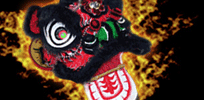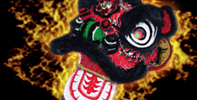The Salute (BOW)
There are many different types of salutes in martial arts. The standard kung fu and tai chi salute is made with the right hand clenched in a fist. The left hand thumb is bent, and the four fingers are stacked and straight. The palm of the left hand is placed over the fist. Both elbows are bent and the arms form a circle. The feet are together with the knees held straight. The posture is erect and the eyes are focused on the person that is being saluted.
For Hung gar students the left hand forms a Fu (tiger) claw and the right a closed fist. The salute is performed from a She bu (empty/cat stance).
Tai chi students make the salute with two palms together (prayer hands) and slightly bow.
A Kung fu salute should be held at chest height, unless you wish to show more or less respect. Many students will bring their hands higher when saluting an altar or Sifu, accompanying it with a slight bow. This shows greater respect. Do not salute with your hands lower than chest level, since this signifies that you are superior to the person you are saluting and could be considered an insult if you are wrong.
When and Why Do we Salute
Salute when entering and exiting the school to honor your training hall. All of this tradition, its majesty and legacy, depends upon what happens here and now, so we salute to show that we will work to preserve these skills and pass them on to future generations in honor of our martial ancestors, our teacher's teachers and the founders of our styles.
Salute or bow when greeting Sigung Smith and all instructors to show respect for their hard work and the dedication that they have endured to achieve those positions. Everyone starts as a beginner, and the challenges that stand before you now stood before each of your instructors at one time before. Salute anyone that you might workout with, especially for blocking exercises and sparring. This signifies that you will work together on these skills, without trying to injure each other. Salute at the beginning and ending of lessons, to signify that this is the lesson time and that your attention will be undivided.
Be first to salute. Do not wait for your senior to salute you. This demonstrates your alertness, quick reflexes and most importantly, your respect. These salutes should be observed at every practice.
Lesson Etiquette
Arrive at your lesson promptly, dressed and warmed up, ready to go. When your instructor signifies that it is your lesson time, quickly gather up your classmates and meet together on the floor. (The same applies for the end of class.)
Lessons are not the time for idle chatter. Make your questions pertinent and give the lesson your full attention. Do not interrupt others during lesson time.
If you cannot make your scheduled time, inform your instructor or call the school. This will allow your instructor to plan his or her lesson schedule for that day ahead of time. If you have an injury that will not allow you to practice with your usual rigor, inform your instructor. The instructors here are very capable of adapting your lessons to your needs.
Some lessons may differ slightly from instructor to instructor. This may be for a variety of reasons. Since many of the techniques have multiple interpretations, different people may have an alternative emphasis. For this reason, do not attempt to teach something to someone unless you are asked to. You may not have the complete technique quite yet, and it would be a shame to teach someone else your own bad habits. During your lesson, be flexible enough to adapt to any variation, without question. Although some things may seem contradictory at first, with practice, you may well find that it was just two ways of saying the same thing.
Some lessons may seem shorter than others. This is usually because that particular technique has some subtle movement that you will only achieve after your have practices it for a while. Be eager to repeat it over and over and over. Do not badger your instructor for more (new) techniques when you have not comprehended the old ones.
Kwoon (School) Etiquette
The school or kwoon is not a place to sit and socialize. While we are all friends and family here, we all came here with the same intention to improve ourselves and our quality of life through this martial discipline. If you have enough breath to talk, you have enough breath to work out. Often times, unnecessary conversation is just another excuse not to practice. If you are tired, it is best to walk in circles, and keep moving. When you sit down, you will cool down, and it is difficult to get back up from there.
- The kwoon is here for practice.
- Eating (except things like sports energy bars and soft drinks), smoking and alcohol are inappropriate behavior on premises. Chewing gum is also not permitted.
- The use of profanity is not allowed.
- Jewelry, rings, watches and any other accouterments must be removed before practice. These objects can cause injuries in sparring and they are expressions of ego, which we leave outside the door of the school.
- Traditionally, the school hierarchy is arranged like a big family. It is the responsibility of each of us to act as a good role model for our youth.
If you decide that you wish to practice beyond your lesson times you are encouraged to do so, but be respectful and mindful of the lesson times of others, for example during the Advanced and Intermediate students class period, because at that time their class has priority. You may participate in the group exercises of other classes with the leading instructor's permission, but do not be obtrusive or disruptive if they practice something that you are unfamiliar with. Do your best to follow along, and ask for clarification later. Each style has its own value, so these variations can be very useful to add some contrast to your repertoire of skills.
Serious Training
- Remember classes are for training.
- Home is where you review your training.
- Come prepared to train.
Respect All Styles
Never belittle other styles. Their strengths may be your weakness.
Training on Your Own Time
If you wish to practice when there are no classes, it is always best to call first, to be sure that the school is open and not being used for something else.
Private/Semi-Private Classes
You can always contact the school about additional classes in all styles.
See Private Classes for more details.
|



 Thursday, January 8
Thursday, January 8  Site Intro
Site Intro Guest Book
Guest Book Contact Us
Contact Us Mailing List
Mailing List Testimonials
Testimonials Coupons
Coupons School Location
School Location Class Schedule
Class Schedule Tien Shan Pai Curriculum
Tien Shan Pai Curriculum Wing Chun Curriculum
Wing Chun Curriculum Tai Chi Chuan Curriculum
Tai Chi Chuan Curriculum Seminars
Seminars Event Calendar
Event Calendar News
News Articles
Articles Photo Gallery
Photo Gallery Products
Products Chinese Terminology
Chinese Terminology FAQ
FAQ


